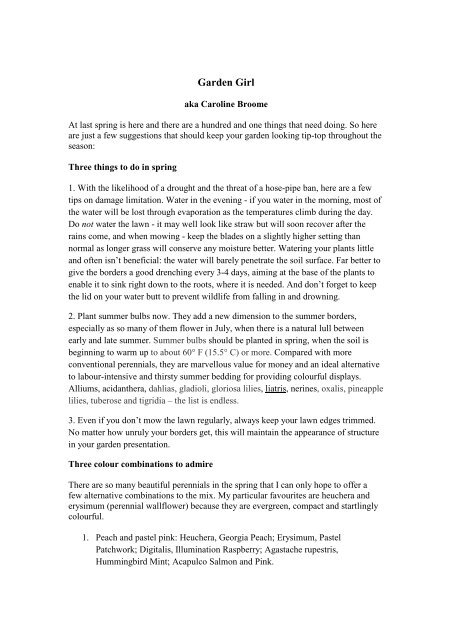Read the April 2012 newsletter here - Hampstead Garden Suburb
Read the April 2012 newsletter here - Hampstead Garden Suburb
Read the April 2012 newsletter here - Hampstead Garden Suburb
Create successful ePaper yourself
Turn your PDF publications into a flip-book with our unique Google optimized e-Paper software.
<strong>Garden</strong> Girl<br />
aka Caroline Broome<br />
At last spring is <strong>here</strong> and <strong>the</strong>re are a hundred and one things that need doing. So <strong>here</strong><br />
are just a few suggestions that should keep your garden looking tip-top throughout <strong>the</strong><br />
season:<br />
Three things to do in spring<br />
1. With <strong>the</strong> likelihood of a drought and <strong>the</strong> threat of a hose-pipe ban, <strong>here</strong> are a few<br />
tips on damage limitation. Water in <strong>the</strong> evening - if you water in <strong>the</strong> morning, most of<br />
<strong>the</strong> water will be lost through evaporation as <strong>the</strong> temperatures climb during <strong>the</strong> day.<br />
Do not water <strong>the</strong> lawn - it may well look like straw but will soon recover after <strong>the</strong><br />
rains come, and when mowing - keep <strong>the</strong> blades on a slightly higher setting than<br />
normal as longer grass will conserve any moisture better. Watering your plants little<br />
and often isn’t beneficial: <strong>the</strong> water will barely penetrate <strong>the</strong> soil surface. Far better to<br />
give <strong>the</strong> borders a good drenching every 3-4 days, aiming at <strong>the</strong> base of <strong>the</strong> plants to<br />
enable it to sink right down to <strong>the</strong> roots, w<strong>here</strong> it is needed. And don’t forget to keep<br />
<strong>the</strong> lid on your water butt to prevent wildlife from falling in and drowning.<br />
2. Plant summer bulbs now. They add a new dimension to <strong>the</strong> summer borders,<br />
especially as so many of <strong>the</strong>m flower in July, when <strong>the</strong>re is a natural lull between<br />
early and late summer. Summer bulbs should be planted in spring, when <strong>the</strong> soil is<br />
beginning to warm up to about 60° F (15.5° C) or more. Compared with more<br />
conventional perennials, <strong>the</strong>y are marvellous value for money and an ideal alternative<br />
to labour-intensive and thirsty summer bedding for providing colourful displays.<br />
Alliums, acidan<strong>the</strong>ra, dahlias, gladioli, gloriosa lilies, liatris, nerines, oxalis, pineapple<br />
lilies, tuberose and tigridia – <strong>the</strong> list is endless.<br />
3. Even if you don’t mow <strong>the</strong> lawn regularly, always keep your lawn edges trimmed.<br />
No matter how unruly your borders get, this will maintain <strong>the</strong> appearance of structure<br />
in your garden presentation.<br />
Three colour combinations to admire<br />
T<strong>here</strong> are so many beautiful perennials in <strong>the</strong> spring that I can only hope to offer a<br />
few alternative combinations to <strong>the</strong> mix. My particular favourites are heuchera and<br />
erysimum (perennial wallflower) because <strong>the</strong>y are evergreen, compact and startlingly<br />
colourful.<br />
1. Peach and pastel pink: Heuchera, Georgia Peach; Erysimum, Pastel<br />
Patchwork; Digitalis, Illumination Raspberry; Agastache rupestris,<br />
Hummingbird Mint; Acapulco Salmon and Pink.


